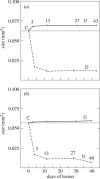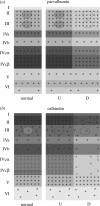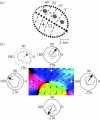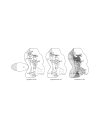Cortical visual areas in monkeys: location, topography, connections, columns, plasticity and cortical dynamics
- PMID: 15937009
- PMCID: PMC1569490
- DOI: 10.1098/rstb.2005.1629
Cortical visual areas in monkeys: location, topography, connections, columns, plasticity and cortical dynamics
Abstract
The visual system is constantly challenged to organize the retinal pattern of stimulation into coherent percepts. This task is achieved by the cortical visual system, which is composed by topographically organized analytic areas and by synthetic areas of the temporal lobe that have more holistic processing. Additional visual areas of the parietal lobe are related to motion perception and visuomotor control. V1 and V2 represent the entire visual field. MT represents only the binocular field, and V4 only the central 30 degrees-40 degrees. The parietal areas represent more of the periphery. For any eccentricity, the receptive field grows at each step of processing, more at anterior areas in the temporal lobe. Minimal point image size increases towards the temporal lobe, but remains fairly constant toward the parietal lobe. Patterns of projection show asymmetries. Central V2 and V4 project mainly to the temporal lobe, while peripherals V2 (more than 30 degrees) and V4 (more than 10 degrees) also project to the parietal lobe. Visual information that arrives at V1 projects to V2, MT and PO, which then project to other areas. Local lateral propagation and recursive loops corroborate to perceptual completion and filling in. Priority connections to temporal, parietal and parieto-temporal cortices help construct crude early representations of objects, trajectories and movements.
Figures










References
-
- Albright T.D. Direction and orientation selectivity of neurons in visual area MT of the macaque. J. Neurophysiol. 1984;52:1106–1130. - PubMed
-
- Allman J.M, Kaas J.H. A representation of the visual field in the caudal third of the middle temporal gyrus of the owl monkey (Aotus trivirgatus) Brain Res. 1971;31:85–105. - PubMed
-
- Allman J.M, Kaas J.H. A crescent-shaped cortical visual area surrounding the middle temporal area (MT) in the owl monkey (Aotus trivirgattus) Brain Res. 1974;81:199–213. - PubMed
-
- Allman J.M, Kaas J.H. The dorsomedial cortical visual area: a third tier area in the occipital lobe of the owl monkey (Aotus trivirgatus) Brain Res. 1975;100:473–487. - PubMed
-
- Allman J.M, Kaas J.H, Lane R.H, Miezin F.M. A representation of the visual field in the inferior nucleus of the pulvinar in the owl monkey. Brain Res. 1972;40:291–302. - PubMed
Publication types
MeSH terms
Substances
LinkOut - more resources
Full Text Sources
Research Materials
